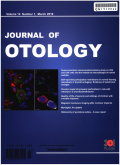- 钛学术文献服务平台 \
- 学术期刊 \
- 医药卫生期刊 \
- 五官科学期刊 \
- 中华耳科学杂志(英文版)期刊 \
Mastoid obliteration and reconstruction techniques:A review of the literature
Mastoid obliteration and reconstruction techniques:A review of the literature
基本信息来源于合作网站,原文需代理用户跳转至来源网站获取
摘要:
Objective: To review the published literature related to the different obliteration and reconstruction techniques in the management of the canal wall down mastoidectomy.Methods: A PubMed (Medline) and LILACS databases as well as crossed references search was performed with the following Mesh terms:"cholesteatoma","cholesteatoma-middle ear","otitis media","otitis media, suppurative","mastoiditis","mastoidectomy","canal wall down mastoidectomy","radical mas-toidectomy","mastoid obliteration"and crossed references. Inclusion criteria were adult patients subject to mastoid cavity obliteration and posterior canal wall reconstruction. The technique and materials used, anatomic and functional results, complications, recurrence rates, and changes in quality of life, were analyzed. A total of 94 articles were screened, 38 were included for full-text detailed review. Results: Twenty-one articles fulfilled the inclusion criteria. Techniques and materials used for canal wall reconstruction, tympanoplasty, and ossiculoplasty were varied and included autologous, biosynthetic, or both. Auditory results were reported in 16 studies and were inconsistent. Three studies reported improvement in the quality of life using the GBI scale. Follow-up time ranged from 1 to 83 months. Eleven articles used imaging studies to evaluate postoperative disease recurrence. The highest recurrence rate reported for cholesteatoma after obliteration was 19%. The most frequently reported complications were retraction pockets and transient otorrhea. Conclusion: Plenty of techniques combining grafts and other materials have been used to overcome mastoidectomy cavity problems. So far, it is still not possible to standardize an ideal procedure. The available level of evidence for this topic is low and limited.

推荐文章
Diffusion in garnet: a review
High temperature and high pressure
Diffusion
Garnet
Point defects
"African-American Literature"的辨析与翻译
美国非裔文学
意义辨析
翻译
译文确定
A review of geoanalytical databases
Database
Geochemistry
Geology
Geoanalysis
Information system
内容分析
关键词云
关键词热度
相关文献总数
(/次)
(/年)
文献信息
| 篇名 | Mastoid obliteration and reconstruction techniques:A review of the literature | ||
| 来源期刊 | 中华耳科学杂志(英文版) | 学科 | |
| 关键词 | |||
| 年,卷(期) | 2021,(3) | 所属期刊栏目 | Review Articles |
| 研究方向 | 页码范围 | 178-184 | |
| 页数 | 7页 | 分类号 | |
| 字数 | 语种 | 英文 | |
| DOI | |||
五维指标
引文网络
引文网络
二级参考文献 (0)
共引文献 (0)
参考文献 (26)
节点文献
引证文献 (0)
同被引文献 (0)
二级引证文献 (0)
1900(1)
- 参考文献(1)
- 二级参考文献(0)
1990(1)
- 参考文献(1)
- 二级参考文献(0)
1991(1)
- 参考文献(1)
- 二级参考文献(0)
2001(1)
- 参考文献(1)
- 二级参考文献(0)
2004(2)
- 参考文献(2)
- 二级参考文献(0)
2005(1)
- 参考文献(1)
- 二级参考文献(0)
2006(1)
- 参考文献(1)
- 二级参考文献(0)
2007(2)
- 参考文献(2)
- 二级参考文献(0)
2008(1)
- 参考文献(1)
- 二级参考文献(0)
2010(1)
- 参考文献(1)
- 二级参考文献(0)
2012(1)
- 参考文献(1)
- 二级参考文献(0)
2014(5)
- 参考文献(5)
- 二级参考文献(0)
2015(2)
- 参考文献(2)
- 二级参考文献(0)
2017(3)
- 参考文献(3)
- 二级参考文献(0)
2018(2)
- 参考文献(2)
- 二级参考文献(0)
2019(1)
- 参考文献(1)
- 二级参考文献(0)
2021(0)
- 参考文献(0)
- 二级参考文献(0)
- 引证文献(0)
- 二级引证文献(0)
引文网络交叉学科
相关学者/机构
期刊影响力
中华耳科学杂志(英文版)
主办单位:
解放军总医院耳鼻咽喉科研究所
出版周期:
季刊
ISSN:
1672-2930
CN:
11-4883/R
开本:
出版地:
北京市复兴路28号
邮发代号:
创刊时间:
语种:
eng
出版文献量(篇)
450
总下载数(次)
0
总被引数(次)
399
期刊文献
相关文献
推荐文献
- 期刊分类
- 期刊(年)
- 期刊(期)
- 期刊推荐

 免费查重
免费查重










